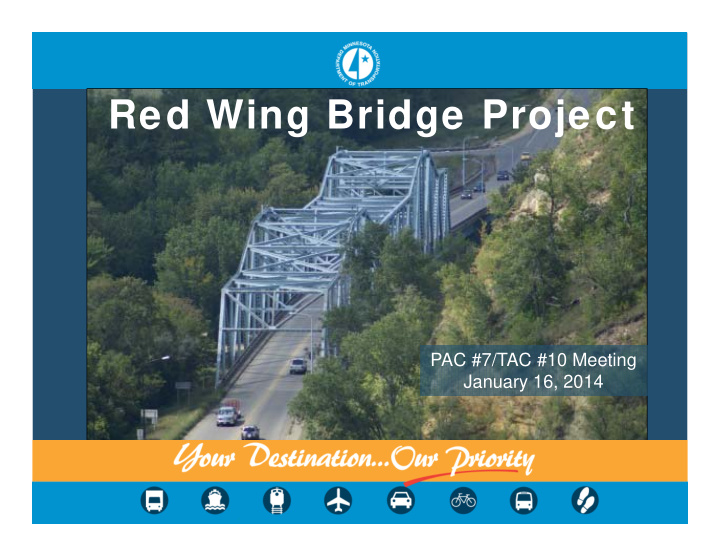



Red Wing Bridge Project PAC #7/TAC #10 Meeting January 16, 2014
Agenda • Process Overview and Progress to Date – What’s Been Accomplished – Minnesota Approach Alternatives – River Crossing • Environmental Assessment Process • Visual Quality Process • Public Outreach Update • Next Meetings
Schedule Overview and Progress to Date • MnDOT and WisDOT began the study and design process seven years in advance of planned construction; – Unique project setting – High value natural and cultural resources; – Applicable federal and state regulations; – Importance of on-going stakeholder involvement • Initial coordination and studies began in 2011; • Alternative Analysis began in early 2012; • Construction is planned for 2018
What’s Been Accomplished • Determined the river crossing will be kept at current location; • Identified and refined a recommended set of concepts for the Minnesota and Wisconsin approach roadways; • Decided to proceed with a new two-lane river crossing;
What’s Been Accomplished (cont…) • Completed Bridge 9103 Rehabilitation Study; • Identified a recommended river crossing bridge type (details to follow….); • Identified a recommended alternative for the Wisconsin approach
Wisconsin Approach – Preferred Option
Minnesota Approach Alternatives – Evaluation Progress • Completed the Bridge 9103 Rehabilitation Study; • Identified and completed an initial screening of a range of options; • Three options were carried forward; • Conducted a comprehensive evaluation of the remaining options in coordination with FHWA
Rehabilitate Bridge 9103
Replace In-place
Buttonhook
Minnesota Approach Alternatives – Next Steps • Coordinating with local and national FHWA staff to ensure full and fair consideration of all factors; • Complete technical evaluation; • Obtain public input; • Identify recommended option(s) to carry forward into the EA process
River Crossing Bridge Type Evaluation
Tied Arch • Grade and Profile • Span Arrangement • Constructability • Inspection and Maintenance
Steel Box Girder • Grade and Profile • Span Arrangement • Constructability • Inspection and Maintenance
Segmental Concrete Box Girder • Grade and Profile • Span Arrangement • Constructability • Inspection and Maintenance
River Crossing- Technical Findings Tied Arch Advantages Disadvantages Shallow structure depth Potential volatility of steel prices Highest construction cost Highest maintenance costs Inspection more difficult
River Crossing- Technical Findings Steel Box Girder Advantages Disadvantages Conventional construction Potential volatility of steel prices Relatively straight forward inspection Requires repainting Opportunity for color enhancement Modest profile impacts (particularly as compared to concrete segmental) Construction cost is nearly as low as the concrete segmental (within 2%)
River Crossing- Technical Findings Concrete Segmental Box Girder Advantages Disadvantages Complex erection is not required Requires substantial profile increase Relatively straight forward inspection Reduced opportunities for color Lowest long term maintenance costs enhancement Lowest construction cost Greatest structure depth Longest distance at maximum grade
Historic Aesthetic Considerations
River Crossing - Recommendation Recommended Alternate: Steel Box Girder
Environmental Assessment (EA) • Detailed impact assessment process addressing federal and state requirements; • One or more “build” alternatives may be evaluated; • Considers full range of social, economic and natural environmental issues; • Continued opportunities for stakeholder involvement; • Concludes with identification of preferred alternative to advance to detailed design and construction
Visual Quality Process • Conducted during preparation of the EA; • Prescribed process centered on engaging community stakeholders; • Primary outcome will be a plan defining the aesthetic elements of the project (i.e. bridge color, lighting, railings, pier design, etc…); • More details regarding the process will be provided at the next PAC and TAC meetings
Public Outreach Update • Listening Session #4 - November 2013 • City Council presentation – November 2013 • Open House #3 – March 2014 (tentative) • Newsletter #3 – to be issued prior to Open House #3 • Project Presentation Opportunities • Website: http://www.dot.state.mn.us/d6/projects/redwing- bridge/index.html
Next Meetings • February 20 th TAC #11 - 1:00 p.m. to 3:00 p.m. – Red Wing Library • March 20 th PAC #8 - 1:00 p.m. to 3:00 p.m. – Red Wing Library
Questions / Comments Chad Hanson, P.E. Senior Design Engineer MnDOT – Rochester 507-286-7637 chad.hanson@state.mn.us
Recommend
More recommend